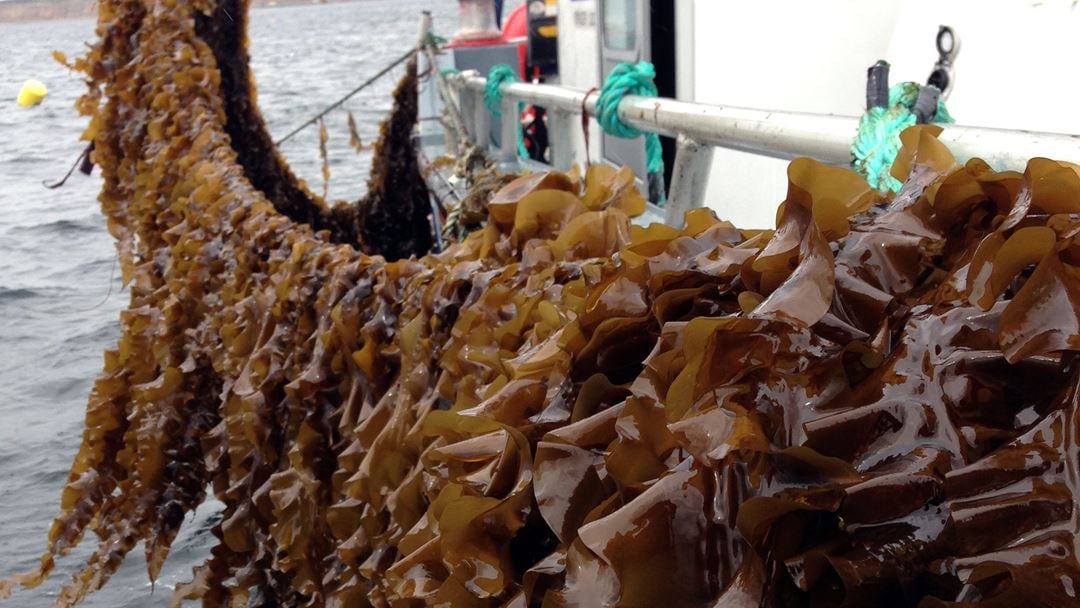58 talks, 4 reports, 4 popular- and 2 scientific articles have been disseminated, and the knowledge platform has contributed to 127 media articles of 'Seaweed cultivation'. The project educates 6 PhD, 8 MSc and 4 BSc students.

A seedlings cultivation protocol for the red P. palmata has been optimized by studying the seasonal dependency for fertility, different methods for spore release from fertile tissue and surface disinfection of sorus (WP1).
A sea cultivation experiment with Palmaria has been carried out as the first in Norway starting with spore release and attachment on nets, incubation for 3 months and deployment in IMTA in winter (Feb). The plants grew slow during the spring, but in June a high density and blades up to 15 cm were registered.
A Palmaria-workshop with participants from research and industry in Northern Europe was arranged in 2017. As a measure to improve the quality in the seedling production 11 different methods for seedlings production and deployment of sugar kelp were tested in 2018. Sporophytes and gametophytes were seeded on twines and incubated for 2 to 6 weeks before spinning on ropes and deployed, in addition cultures of gametophytes and microscopic sporophytes were seeded directly on cultivation ropes.
We have developed image analysis methods for effective counting of gametophytes on seeded material before deployment (WP1 and WP5). A lab experiment has been conducted with N-saturated and N-starved juvenile S. latissima (8-12 cm in length) to study N-uptake of nitrate and ammonia (WP2). Results are under treatment and one MSc-thesis by V.R. Dahlen has been published: "Characterization of the initial ammonium uptake in S. latissima: Possible implications for an IMTA system with intensive salmon farming".
A Regional monitoring programme has been performed with S. latissima. Seeded ropes were deployed at 10 sites in Feb 2017 followed by registrations from Apr to Sep. Chemical analysis of amino acids, heavy metals, CN, internal nitrate, ash and dry matter is complete, and carbohydrate content and biofouling data is being analysed.
Two MSc-thesis have been published: "Morfologiske relasjonar til dyrka S. latissima ved tre stasjonar langs Norskekysten" by S. Foldal, and "The effects of variable environmental conditions on growth, nutritional state and protein content in cultivated S. latissima in Norway" by Guri E. Brodahl. The results will significantly improve the sugar kelp growth model in SINMOD (WP4). A field trial has been conducted on the date of deployment (Feb, Apr, May) of S. latissima related to growth, internal nitrate-N, C/N and fouling in Tromsø. Preliminary results show a difference between the deployment dates in amount of biofouling and growth.
Samples of S. latissima for population genetics (microsatellite-analysis) have been collected along the Norwegian coast and along Sognefjorden in a gradient from the innermost parts to the outer coastal parts, as well as from Hardangerfjord and the coastal parts between the two fjords to study degree of local population connection and gene flow in a fjord seascape (WP3).
A RNA-Library will be created and transcriptional analysis of samples from a common-garden experiment with sugar kelp from Tromsø, Trondheim and Bergen will be done.
An advanced model for self-shading within kelp cultures has been implemented in SINMOD (WP4). Adaptations to next generation seaweed rope spinner for in situ use in deployment are being studied. The seeding time/speed (meter seeded rope per day) has been increased 6-10 times in MACROSEA.
Work on the R&D requirements for an industrial production line for seedlings is finalized. See reports about this and automated seeding systems, and an animation of a new production concept for large scale production, SPOKe, on www.macrosea.no.
Design elements regarding rope attachment methods have been developed, and a new master student will work on a robot for automated deployment and harvesting. To develop a numerical model of drag-measurements towing experiments were conducted at NTNU in 2017 (WP6).Two simplified artificial models of Saccharina latissima were tested. Drag forces were measured at different velocities, while the movement of the models were recorded by an underwater camera. Towing experiments at sea were conducted in 2016 and 2017. In the first set of sea trials a rope with sugar kelp were attached to a rigid frame at the bow of a research vessel, while the tests in 2017 were performed by towing a raft – with a 1 m long rope with sugar kelp attached - 100 meters behind the vessel. Loads and towing velocities were measured in both experiments.
In 2018 tests with cultivated sugar kelp were conducted in a closed test facility containing seawater. Towing velocities, drag forces and tensile forces in the rope were measured. Data from the experiments are to be analysed and used for developing a model for hydrodynamic loads on sugar kelp.
